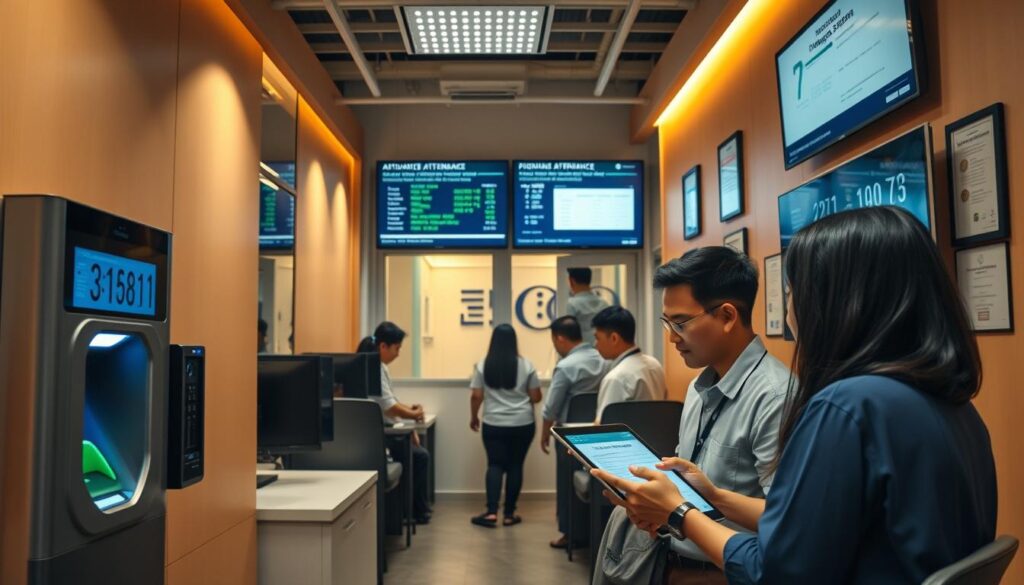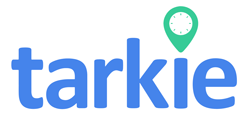Are you still using old ways to track when employees are at work? This could put you at risk of breaking local labor laws. In the Philippines, following Department of Labor and Employment (DOLE) rules is very important. Using old methods can lead to big legal problems.
Automated attendance logs are a better choice. They make tracking more accurate and protect businesses from legal issues. With the right HR software, companies can make scheduling easier, cut down on mistakes, and follow the rules better.
This article will explore how automated attendance systems work. It will show how they help follow labor laws and make businesses run smoother in the Philippines.
Key Takeaways
- Businesses can reduce compliance-related fines by as much as 90% through automated attendance logs.
- Switching to automated systems is associated with a 47% improvement in compliance with local labor laws.
- 82% of employees prefer automated tracking methods for their accuracy and transparency.
- Companies using automated attendance systems save an average of 20 hours per month in payroll processing time.
- 67% of employers noted improved compliance with local labor laws post-automation.
Understanding the Importance of Attendance Compliance
Attendance compliance is key to a fair work environment. It ensures employees’ rights are respected and they are treated fairly. Companies that follow these rules avoid legal troubles and penalties, which can harm their reputation.
By enforcing attendance rules, companies offer fair pay and conditions. This leads to happier employees, less turnover, and better work. Automated logs help track attendance, making it easier to follow labor laws. This way, businesses can show they care about their employees’ rights.
Why Compliance Is Essential for Businesses
Following labor laws protects businesses from many risks. Here are some main reasons why it’s crucial:
- Prevention of Legal Issues: Breaking the rules can lead to lawsuits and fines, hurting the company’s finances.
- Enhanced Employee Trust: Respecting employee rights builds trust and loyalty among workers.
- Effective Resource Management: Following attendance rules helps plan and use human resources better.
- Promotion of a Positive Workplace Culture: A fair and responsible work environment makes employees thrive.
In summary, strong attendance compliance, backed by automated logs, keeps businesses in line with labor laws. It also creates a healthy and productive workplace. By focusing on these areas, employers build a strong community that values both employee rights and ethics.
The Role of Automated Logs in Workforce Management
Automated logs are key in improving how we manage our workforce. They help track and report on when employees are at work. This leads to better operations, thanks to HR software and digital timekeeping.
By using real-time data, companies can cut down on mistakes. This makes it easier to use resources well.
Enhancing Operational Efficiency
Automated logs help ensure payroll is always right. This keeps finances stable and makes employees happy. They give updates on who’s working and use cool tech like facial recognition.
This tech is great for all kinds of businesses. It helps manage who’s working and how much they get paid.
- Real-time updates cut down on paperwork.
- Biometric logs solve disputes over work hours.
- The employee self-service portal makes it easy to see payslips and file requests.
- Outsourcing disciplinary actions makes paperwork more efficient.
HR teams can make better choices with accurate data. This keeps them in line with DOLE rules. Paying employees on time is crucial to avoid legal trouble and keep morale up.
Checking the digital timekeeping regularly helps avoid problems. This keeps companies compliant with rules.
Using automated logs with HR software boosts compliance and productivity. It gives businesses the tools to manage their teams well. This keeps employees happy and the company in line with the law.
Key Local Labor Laws and DOLE Regulations
It’s crucial for businesses in the Philippines to know the local labor laws and DOLE regulations. These rules help ensure fair wages, proper working hours, and leave entitlements. They protect both employers and employees, creating a balanced workplace.
Following these laws helps avoid legal issues and boosts a company’s reputation.
Overview of Relevant Regulations
The “Rules to Implement the Labor Code” are key for understanding local labor laws. They define important terms like “Bureau,” “NSB,” “OEDB,” and “Private employment agency.” This knowledge is vital for recruitment processes.
Non-resident aliens need employment permits to work legally in the Philippines. This shows the importance of following immigration rules.
The Philippine Overseas Employment Administration oversees labor laws for overseas work. It’s important for organizations and workers to know about placement fees. Public employment offices offer free services for job seekers, both locally and abroad.
Employers with six or more employees must report monthly to public employment offices. They need to provide detailed information on job vacancies, new hires, and total employment. The minimum employment age in the Philippines is 15, but workers aged 15 to 18 must not miss school.
Regular working hours are eight hours a day, with a one-hour meal break. Overtime work gets a 25% pay increase. Employees get extra pay for work on rest days, showing respect for their time and rights. The Philippines aims to create a fair work environment for everyone.
How Automated Attendance Systems Streamline Compliance
Automated attendance systems help manage employee hours well. This makes it easier for businesses to follow local labor laws. HR teams can then focus on important tasks instead of just tracking hours.
These systems make reporting automatic. This helps businesses stay up-to-date with labor laws. They can quickly adjust to any new rules.
Reducing Administrative Burden
Automated attendance systems make record-keeping easier. They offer features like automated time reporting and checks for policy adherence. This way, they reduce errors that come with manual tracking.
By automatically calculating hours, these systems ensure accuracy. This is key for following the Labor Code of the Philippines, which deals with working hours and pay.
HR software can also help manage employee hours better. For example, geolocation tracking lets companies monitor work hours in real-time. This helps both the company and its employees.
With a user-friendly interface, employees can easily check their information. This leads to happier employees and more transparency.

| Feature | Manual Tracking | Automated Attendance Systems |
|---|---|---|
| Time Calculation | Prone to errors | Accurate and real-time |
| Reporting | Time-consuming | Instant and automated |
| Policy Compliance | Requires manual oversight | Built-in compliance checks |
| Employee Accessibility | Limited online access | Comprehensive self-service portals |
By regularly checking attendance records, businesses can spot trends or issues. This helps them address problems early. It also encourages open communication between employees and management.
This approach helps businesses follow local labor laws well. It ensures they operate fairly and smoothly.
Enhancing Employee Accountability Through Automated Tracking
Automated tracking makes it easier to keep track of work hours. This is crucial because of strict labor laws. It helps prevent dishonesty at work.
Studies show that 19% of employees cheat on their timesheets. And 43% of hourly workers lie about their hours. Automated tracking helps stop these problems.
Using automated systems makes employees more responsible. They can see their work history and leave requests. This makes them feel more in charge of their jobs.
Systems that use biometric data are very effective. Only 3% of employees can cheat without getting caught. This helps follow the law and keeps employees honest.
Promoting a Culture of Responsibility
Creating a responsible work culture is key. It helps manage the team and lowers risks. Companies like Buddy Punch help over 10,000 businesses fight time theft.
They have a great rating of 4.8 out of 5 stars on Capterra. This shows how much value these tools have for businesses.
The Fair Labor Standards Act (FLSA) makes employers responsible for tracking work hours. Not doing this can lead to problems with pay and following the law. The American Payroll Association says biometric tracking is the best way to stop time theft.
| Statistic | Implication |
|---|---|
| 19% participate in timesheet fraud | Indicates need for automated attendance systems |
| 43% exaggerate work hours | Highlights risks of manual tracking |
| 3% bypass biometric systems | Emphasizes efficacy of automated tracking |
| Buddy Punch supports over 10,000 businesses | Shows popularity and effectiveness |
| 4.8 out of 5 stars rating | Reflects customer satisfaction |
Benefits of Automated Logs for SMEs in the Philippines
Small and medium enterprises (SMEs) in the Philippines gain a lot from automated logs. These systems help manage resources and time better. They also make sure employees follow attendance rules and improve how teams work together.
Optimizing Resources and Time
Automated logs make it easier to handle payroll and track who’s working. This means HR teams can spend more time on growing the business and keeping employees happy. Automated logs give SMEs the data they need to understand their workforce better.
- Improved payroll accuracy reduces discrepancies and ensures timely salaries.
- Real-time tracking of working hours promotes compliance with local labor laws.
- Enhanced access to personnel information boosts employee satisfaction and reduces HR inquiries.
By looking at employee trends, SMEs can make their workforce better. This leads to more productivity and saves money. Automated logs also help SMEs follow labor laws, avoiding legal problems.

| Benefit | Impact on SMEs |
|---|---|
| Time Savings | Allow HR to focus on strategic initiatives |
| Reduced Errors | Enhances payroll accuracy and compliance |
| Improved Employee Satisfaction | Boosts morale and engagement through transparency |
| Cost Efficiency | Minimizes expenditure related to labor disputes |
Switching to automated logs shows SMEs care about fair labor practices. It’s a smart move to stay ahead in the Philippines’ fast-changing economy.
Significant Features of Effective Attendance Compliance Software
Good attendance compliance software has many tools to make things easier for users. It also helps keep track of who is following the rules. This makes managing the workforce better and ensures everyone follows local laws.
Essential Tools for Enhanced Compliance
Some key tools in attendance compliance software include digital timekeeping. This makes tracking easier. It includes features like:
- GPS tracking to accurately monitor employee locations.
- Mobile access enabling employees to check-in from anywhere.
- Automated notifications to alert staff to important deadlines or changes in schedules.
- Real-time attendance reports that provide management with immediate insights.
It also works well with other HR systems. This makes everything run smoothly together. It’s important for keeping payroll accurate, which is key for following overtime laws in the Philippines.
Another important part is the automated logs that show exactly how many hours employees work. This helps avoid arguments by proving who worked when. It’s very important for following strict overtime laws in the Philippines.
| Feature | Description | Benefit |
|---|---|---|
| GPS Tracking | Allows tracking of employee locations during work hours. | Reduces time theft and enhances accountability. |
| Mobile Access | Enables employees to clock in/out remotely. | Improves flexibility and convenience. |
| Automated Notifications | Alerts employees about schedules and compliance updates. | Keeps everyone informed and reduces confusion. |
| Real-Time Reports | Provides up-to-date attendance data. | Aids in quick decision-making and workforce planning. |
| Integrated Payroll Systems | Links attendance data directly to payment processing. | Ensures accuracy in employee wages and reduces errors. |
Using these features helps companies stay in line with rules. It also makes sure the workplace is fair for everyone.
Integration of Automated Attendance Systems with Payroll
Integrating automated attendance systems with payroll is key for businesses. It boosts efficiency and follows labor laws. This makes payment processes smoother and cuts down on errors from manual data entry.
With real-time data, companies can pay accurately. This supports attendance compliance and meets regulatory needs.
Streamlining Payment Processes
Automated attendance systems help HR departments a lot. They bring many benefits:
- Increased Accuracy: Automated payroll systems cut down on human errors. This leads to more accurate wage calculations.
- Timely Payments: Real-time data helps in quick payroll processing. This is key for keeping employees happy and trusting.
- Cost Reduction: Automating payroll saves money. Businesses can then focus on planning and growth.
- Enhanced Compliance: Companies follow labor and tax laws better. This is thanks to the Bureau of Internal Revenue (BIR) and the Department of Labor and Employment (DOLE).
- Improved Record-Keeping: Automated systems keep detailed records. This makes audits easier and promotes transparency.

Businesses like those using Astra Human Resource Information System (AHRIS) get special benefits. This software makes complex tasks like final pay and 13th month pay easier. It also helps follow local laws.
This leads to a well-organized payroll system. It’s something developers can tailor to fit different business needs. As companies aim to follow attendance compliance and labor laws, this integration is crucial for managing the workforce today.
Challenges of Manual Attendance Tracking and Compliance
Manual attendance tracking can cause big problems for businesses. It often leads to errors in data entry, makes it hard to track employee hours, and limits visibility into attendance patterns. These issues can put companies at risk of legal trouble for not following labor laws.
Identifying Common Issues
Manual attendance solutions can make it tough for companies to keep up with attendance rules. Here are some common problems that can happen:
- Inaccurate Data Entry: Mistakes in manual logging can cause wrong hours to be reported.
- Time Theft: Unapproved hours logged, whether on purpose or by mistake, raise compliance concerns.
- Employee Frustration: Poor tracking can lower employee morale and hurt productivity.
- Inability to Monitor Attendance Patterns: Limited tracking methods can hide trends and compliance issues.
- Difficulty in Satisfying Legal Requirements: Without accurate records, following labor laws becomes harder, increasing the risk of violations.
Ignoring these problems can lead to fines and legal issues due to labor law violations. Companies should move to automated attendance systems to avoid these problems. A modern system keeps accurate records and follows legal rules, making it easier to meet attendance compliance.
Best Practices for Implementing Automated Attendance Logs
Automated attendance logs can make work better and follow rules better. To do this right, companies should follow best practices. These help everyone get used to the new system and work better together.
Strategies for Success
Here are some tips for using automated attendance logs well:
- Comprehensive Training: Teach staff how to use the new system well. This helps them not get frustrated and use it more.
- Clear Communication: Tell everyone how the system works and what the rules are. This makes sure everyone knows how to use it right.
- Avenues for Feedback: Let employees share their thoughts and ideas about the system. This makes them feel more involved and happy.
- Regular Audits: Check attendance records often to make sure they’re correct. Fix any mistakes right away.
- Prioritize Integration: Make sure the new system works well with what you already have. This makes things easier and more accurate.

By following these steps, companies can track attendance better and follow laws better. Getting employees involved makes them more committed to the system. This leads to a better work environment for everyone.
How Automated Logs Ensure Compliance with Local Labor Laws, Attendance Compliance, and DOLE Regulations
Automated logs are key for businesses to follow local labor laws and DOLE rules. They make tracking attendance easier and help meet legal standards. With real-time data, these logs help keep accurate records of who’s working and when.
This is super helpful during audits or inspections. It lets businesses deal with labor laws’ complexities with confidence.
The Intersection of Technology and Compliance
Using modern tech for tracking attendance boosts legal compliance. Automated logs fit into daily work, helping manage who’s on the clock. This is important because DOLE rules require keeping detailed records.
Not following these rules can lead to big problems, like fines or legal trouble. Automated systems also make it easier to handle employee hours. They cut down on paperwork, letting managers focus on important tasks.
They also make it simple to create detailed reports. This is great for meeting attendance tracking needs. For more on tracking solutions, check out this guide on software features for remote work.
Conclusion
Automated attendance logs are key to following local labor laws and DOLE rules. They help track employee hours accurately. This is crucial for sticking to the “no work, no pay” rule in the Philippines.
These systems help businesses keep an eye on when employees are late or absent. This way, they can follow fair rules for discipline. It helps both workers and bosses.
Automated logs also make employees more accountable and help with payroll. This makes work more efficient. Employers can follow minimum wage laws and handle disciplinary actions better.
For small and medium businesses in the Philippines, these systems are a smart choice. They help create a clear and fair work environment that follows the law.
Using automated attendance systems improves how businesses follow the law. It also makes the workplace better and more productive. By being open and fair, companies meet legal standards and create a good work place.
